Why you can trust Tom's Hardware
PNY XLR8 CS3140 1TB SSD
RATING: ★★★★ (4 Stars)
PROS
+ Consistent performance
+ Strong peak and all-around performance
+ Power-efficient
+ Good PlayStation 5 option from PNY
CONS
- Pricing
OUR VERDICT
The 1TB PNY CS3140 is a solid drive that can be used in a PC or in the PlayStation 5, but the latter is best with PNY’s separate PS5 heatsink. Performance is strong, but there’s not much special about this drive versus the competition.
Comparison Products (1TB)
We compared the PNY CS3140 to other PCIe 4.0 drives, including the more budget-oriented WD Black SN770. Contenders using proprietary controllers include the WD Black SN850, the Samsung 980 Pro, and the Crucial P5 Plus. The other three drives use the same Phison E18 controller, but the Gigabyte Aorus Gen4 7000s and Corsair MP600 Pro use the older 96-layer Micron TLC while the last one, the Kingston Fury Renegade, is equipped with the same 176-layer flash as the CS3140.
Trace Testing - 3DMark Storage Benchmark
Built for gamers, 3DMark’s Storage Benchmark focuses on real-world gaming performance. Each round in this benchmark stresses storage based on gaming activities including loading games, saving progress, installing game files, and recording gameplay video streams.
Get Tom's Hardware's best news and in-depth reviews, straight to your inbox.



3DMark shows off WD’s excellent optimization, but thanks to their upgraded flash, we also had respectable results for the CS3140 and Fury Renegade.
Trace Testing – PCMark 10 Storage Benchmark
PCMark 10 is a trace-based benchmark that uses a wide-ranging set of real-world traces from popular applications and everyday tasks to measure the performance of storage devices.
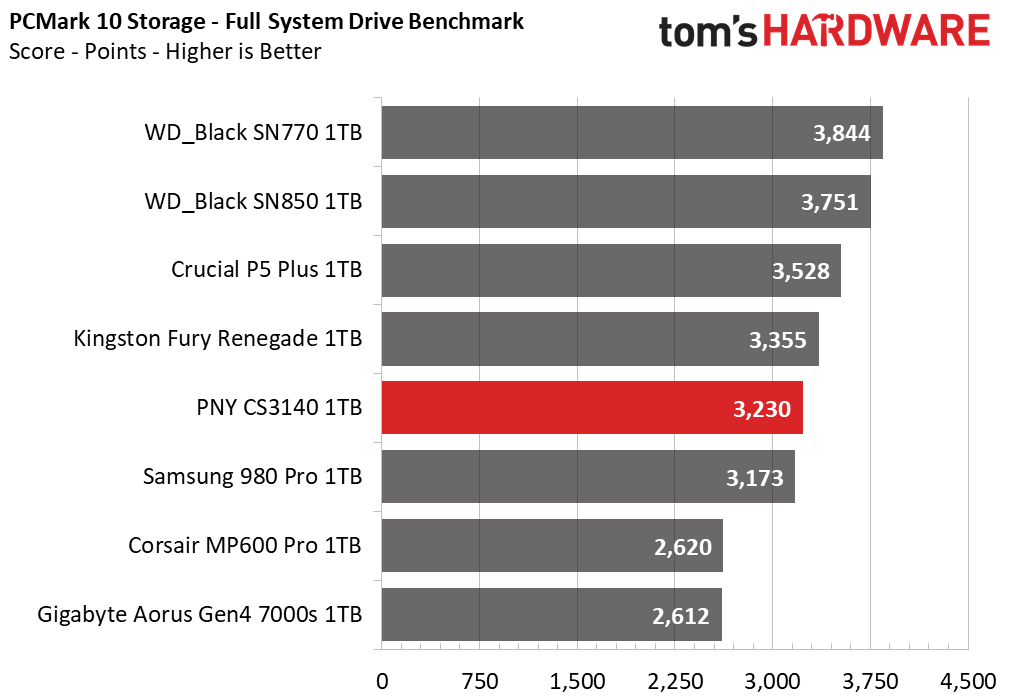


Again we see strong optimization from WD and Crucial, with the newer flash helping out the CS3140 and Fury Renegade. PCMark is often considered a “real world” benchmark, and we can look particularly at the latency results to see that the older 96-layer flash on the 7000s and MP600 Pro is appreciably slower.
Transfer Rates – DiskBench
We use the DiskBench storage benchmarking tool to test file transfer performance with a custom, 50GB dataset. We copy 31,227 files of various types, such as pictures, PDFs, and videos to a new folder and then follow-up with a reading test of a newly-written 6.5GB zip file.


This bandwidth-heavy test favors the high-end PCIe 4.0 drives, particularly those based on the Phison E18 controller. The newer 176-layer flash also brings improvements, particularly as we are testing at 1TB rather than 2TB of capacity. The Phison E18 can peak with 32 dies of flash, and considering these use 64GB dies, that means 2TB. The 176-layer flash is also faster per die than the 96-layer flash for copying tasks.
Synthetic Testing - ATTO / CrystalDiskMark
ATTO and CrystalDiskMark (CDM) are free and easy-to-use storage benchmarking tools that SSD vendors commonly use to assign performance specifications to their products. Both of these tools give us insight into how each device handles different file sizes.






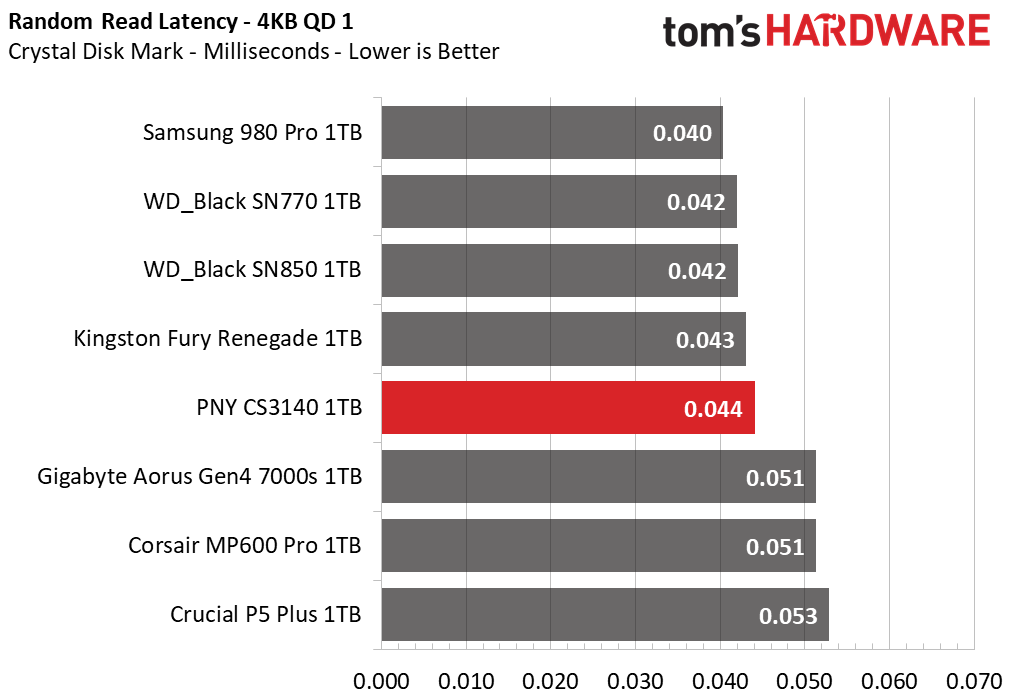

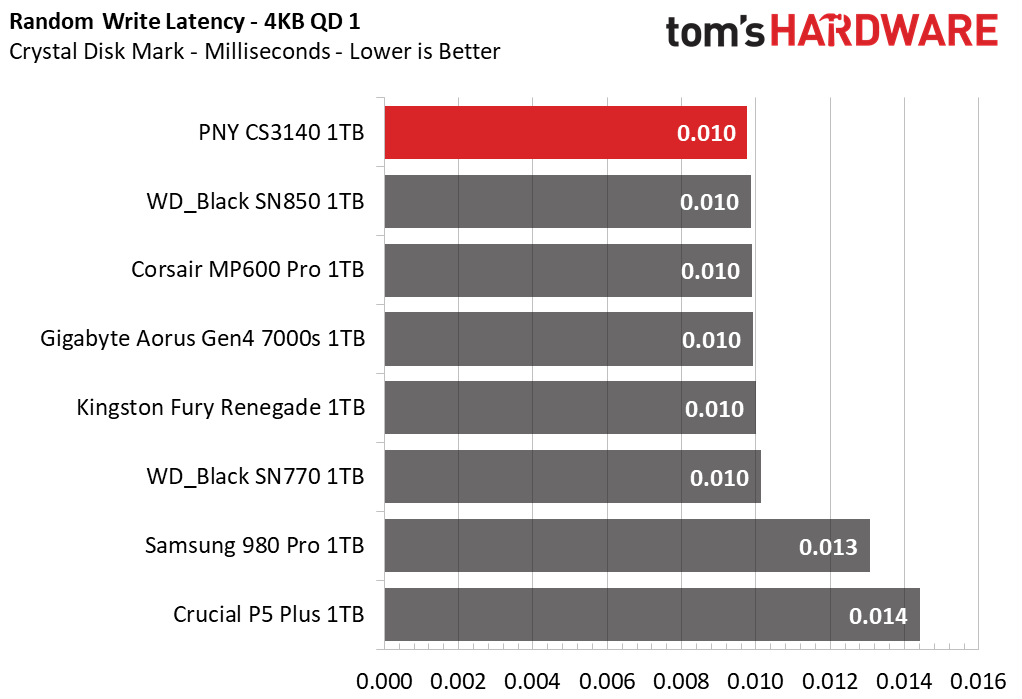

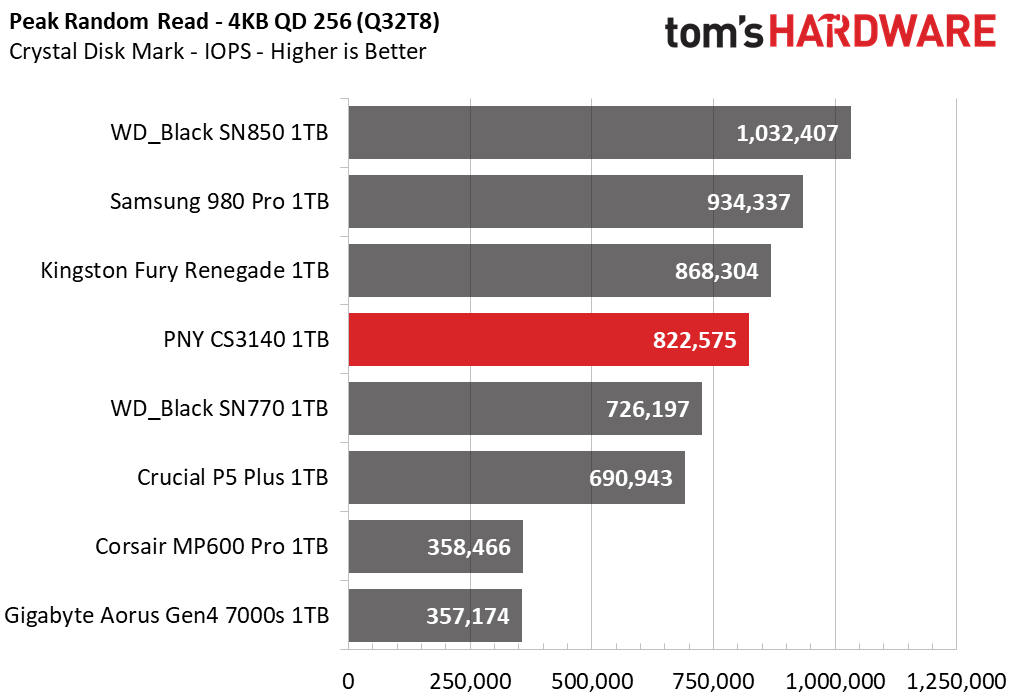
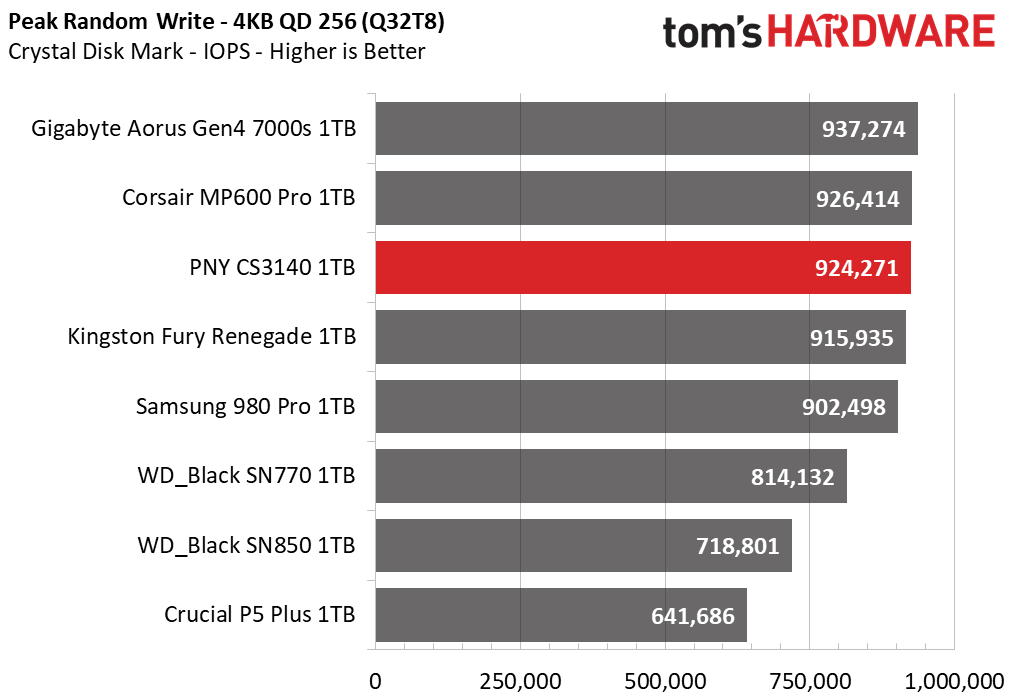


The queue depth 1 (QD1) sequential read and write results from ATTO paint a simple picture: drives using the Phison E18 come out on top, with a significant edge given to those with the newer 176-layer flash. To some extent, there is a “wall” due to the limits of the x4 PCIe 4.0 interface, as seen with queue depth 8 sequential reads in CrystalDiskMark. The write result shows a bit more delineation between the tested drives. At this point, we see a theme, with the CS3140 underperforming the Fury Renegade, possibly due to inferior firmware optimization.
Random QD1 performance is good to excellent on the CS3140, where we again see the newer flash pulling ahead. Again, no real surprises, which is not a bad thing — this hardware configuration performs very well on multiple fronts.
Sustained Write Performance and Cache Recovery
Official write specifications are only part of the performance picture. Most SSDs implement a write cache, which is a fast area of (usually) pseudo-SLC programmed flash that absorbs incoming data. Sustained write speeds can suffer tremendously once the workload spills outside of the cache and into the "native" TLC or QLC flash. We use Iometer to hammer the SSD with sequential writes for 15 minutes to measure both the size of the write cache and performance after the cache is saturated. We also monitor cache recovery via multiple idle rounds.





The CS3140 writes at above 5.8 GBps for almost 20 seconds, revealing an SLC cache of around 116GB. This is not a particularly large cache but should be more than sufficient for a 1TB SSD. The drive then hits its direct-to-TLC phase at up to 2 GBps, which is quite fast for a 1TB drive. This reflects the choice of having a smaller SLC cache while using the faster 176-layer TLC. Performance would be higher at 2TB due to additional interleaving. As the cache is dynamic, it will shrink as the drive is filled. It’s still possible to hit a slower state with sufficient writing, but this is difficult to achieve.
Beyond flash choice, the size of the cache is one thing that separates drives based on the E18 controller. As we can see here with the Fury Renegade’s results, it has a larger, faster cache than the CS3140, but no middle-ground TLC state — this allows some flexibility for the manufacturer and the user. While cache recovery remained slow on both drives, the CS3140's ability to maintain TLC speeds ensures it has better steady state performance for edge cases.
Which is better is arguable, particularly as high-end PCIe 4.0 drives tend to focus on raw bandwidth. However, we believe in the future that sustained performance may become more important. For example, if you’re able to stream assets steadily from a drive via DirectStorage. That would be reads and not writes, of course, but there are nevertheless cases where consistency trumps peak performance alone.
Power Consumption and Temperature
We use the Quarch HD Programmable Power Module to gain a deeper understanding of power characteristics. Idle power consumption is an important aspect to consider, especially if you're looking for a laptop upgrade as even the best ultrabooks can have mediocre storage.
Some SSDs can consume watts of power at idle while better-suited ones sip just milliwatts. Average workload power consumption and max consumption are two other aspects of power consumption, but performance-per-watt is more important. A drive might consume more power during any given workload, but accomplishing a task faster allows the drive to drop into an idle state more quickly, ultimately saving energy.
We also monitor the drive’s temperature via the S.M.A.R.T. data and an IR thermometer to see when (or if) thermal throttling kicks in and how it impacts performance. Remember that results will vary based on the workload and ambient air temperature




Efficiency remains strong on the CS3140, thanks to the flash and the ability to quickly finish workloads with high peak performance. It still trails the Fury Renegade by a small bit.
According to both SMART and the IR gun, the CS3140 idles in the mid-40Cs and peaks in the upper-70Cs. This is hot but not unexpected as the drive lacks a heatsink. The smaller SLC cache helps when the drive hits the TLC flash, but sustained writes still get it pretty close to the throttling mark. In fact, we did see light throttling after about 215GB of writes when the drive hit 78C. Therefore, we recommend a heatsink if you anticipate having heavier workloads and/or a hotter environment.
Test Bench and Testing Notes
| CPU | Intel Core i9-11900K |
| Motherboard | ASRock Z590 Taichi |
| Memory | 2x8GB Kingston HyperX Predator DDR4 5333 |
| Graphics | Intel UHD Graphics 750 |
| CPU Cooling | Alphacool Eissturm Hurricane Copper 45 3x140mm |
| Case | Streacom BC1 Open Benchtable |
| Power Supply | Corsair SF750 Platinum |
| OS Storage | WD_Black SN850 2TB |
| Operating System | Windows 10 Pro 64-bit 20H2 |
We use a Rocket Lake platform with most background applications such as indexing, windows updates, and anti-virus disabled in the OS to reduce run-to-run variability. Each SSD is prefilled to 50% capacity and tested as a secondary device. Unless noted, we use active cooling for all SSDs.
Conclusion

We didn't expect any surprises, and we didn't find any — the PNY XLR8 CS3140 gets close to our performance expectations without any weirdness. As with similar drives, the peak and general performance ranges from good to excellent. The SLC caching scheme is conservative, making for consistent performance in sustained workloads, and the new flash ensures good power efficiency. The PNY CS3140 is also a strong choice for a PlayStation 5 drive due to its option for a tailored heatsink.
On the other hand, there’s not much to set this drive apart from the competition. It is nice to see a functioning SSD toolbox — this is something lacking with, say, Inland drives — but the pricing isn’t particularly competitive. That being said, this is an adequate alternative and would be a good choice if you can find it on sale. PNY isn't pulling any endurance shenanigans here as far as we could tell, even if the company is a bit shy about some of the drive's specifications.
We scored the Kingston Fury Renegade a bit higher. The Fury Renegade edges out the CS3140 in almost every test while coming with cloning software, although currently, it is more expensive. The Kingston SSD is also designed for the PlayStation 5 and is perhaps a more trusted brand, perhaps except for those users who remember the ancient NAND switch-a-roo.
We also previously reviewed the Silicon Power XS70, a similar drive that's also designed for the PlayStation 5. It costs less than the CS3140 and comes with a PS5-capable heatsink out of the box. All of this makes it hard to give the PNY XLR8 CS3140 a higher score, but it is still a strong drive and contender. The biggest challenge for the XLR8 CS3140 is that it's in an increasingly crowded market, but it is a competent alternative.
MORE: Best SSDs
MORE: Best SSD for the Steam Deck
MORE: Best Hard Drives
MORE: Best External SSDs

Shane Downing is a Freelance Reviewer for Tom’s Hardware US, covering consumer storage hardware.

